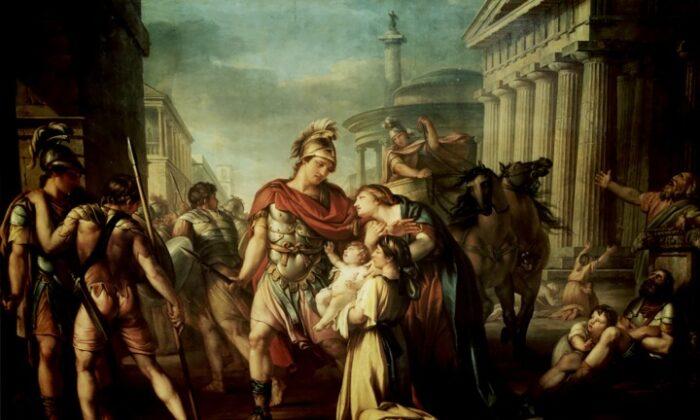In Homer’s poem “The Iliad,” the Trojan hero Hector and the Greek hero Achilles are destined for a showdown from the very beginning.
The poem marches with unwavering steps toward this inevitable conclusion, like the marching ranks of Trojan and Greek soldiers on the blazing plain before Troy. The coming duel between the greatest warriors on each side remains ever-present throughout the seemingly endless struggle of the armies on the beaches before the city, caught between the “hallowed heights of Troy” and the “fish-filled seas,” suspended between human civilization and the wild unknown of the afterworld.
Achilles’s Rage
The late 8th- or early 7th-century epic poem is set during the Trojan War, but it does not tell the story of the war. We see neither the beginning nor the end of the siege within the lines of “The Iliad.” It is concerned, rather, with a smaller drama within this large drama: the story of the rage of Achilles.
The famous opening lines run: “Rage—Goddess, sing the rage of Peleus’ son Achilles, / murderous, doomed, that cost the Achaeans countless losses” (Fagles translation). Due to a squabble with the Greek commander Agamemnon, Achilles refuses to fight for most of the poem. And since he is the Greeks’ champion, a veritable death-machine in combat—perhaps the greatest warrior in all of literature and myth—his absence hurts his own side greatly.
Many Greeks die as a result of Achilles’s rage against Agamemnon that keeps him from battle.
For most of the poem, Achilles has no control over himself. He sulks in his tent day by day, consumed by a sizzling, festering anger, believing himself insulted by Agamemnon. The plight of his comrades can’t touch Achilles’s heart, wringed as it is with wrath.

Only the death of someone Achilles personally cares about brings him back into the fight. But even then, he acts with reckless, blind anger, though now it’s directed at his enemies, especially Hector.
Achilles’s aggressive behavior is destructive—to both the Trojans and his own side, the Greeks—because it is selfish and uncontrolled, driven by irrational passion. Upon the death of his friend, Achilles launches himself on a chaotic rampage against the Trojans, unleashing his violent energy in a blind, animalistic manner.
At the end of his rampage, Achilles, bent on getting revenge for the death of his friend, comes face to face with his nemesis, Hector.
Hector shares many of Achilles’s traits but with important differences. Hector, too, is a powerful force in battle, singlehandedly scattering enemy troops. Homer compares him to a powerful west wind and a strong lion.
The Greeks fear him, and with good reason: “Hector harried the long-haired Argives, killing the last stragglers, man after lagging man and they, they fled in panic” (Book VIII). Hector’s forcefulness on the field of battle along with his strong leadership holds the defense of the city together. In Book VI, Homer says that Hector is the “lone defense of Troy.”

Hector’s Masculinity
But Hector is more than just a ferocious fighter. He has an extraordinarily gentle side, and here is where he differs from Achilles. He is calm and courteous when inside Troy. He even speaks kindly to Helen, who is one of the main causes of his grief, since it was her elopement with Hector’s brother Paris that set off the war.“She [his wife] joined him now, and following in her steps A servant holding the boy against her breast, In the first flush of life, only a baby, Hector’s son, the darling of his eyes and radiant as a star … The great man of war breaking into a broad smile, his gaze fixed on his son, in silence … … shining Hector reached down for his son. … And … laughed, [Andromache] laughed as well, and glorious Hector, quickly lifting the helmet from his head, set it down on the ground, fiery in the sunlight, and raising his son he kissed him, tossed him in his arms, lifting a prayer to Zeus and the other deathless gods … So Hector prayed and placed his son in the arms of his loving wife. Andromache pressed the child to her … smiling through her tears. Her husband noticed, and filled with pity now, Hector stroked her gently, trying to reassure her.”
Andromache fears that Hector will die, and it’s true that he is at great risk—but it is a risk he takes for her sake, to protect her and their entire city. Here we see that Hector’s ferocity is not blind or rage-induced, like Achilles’s is.It is rational, calculated. Its purpose is simply to defend what he loves. He is in control of his dangerous side and channels it solely for the benefit of others; he would never hurt his own people or family. This is what true masculinity looks like.

True masculinity controls the forceful, dangerous side of male nature to direct it to good and self-sacrificing ends. By contrast, Achilles has not tamed the aggressive side of his male nature, nor does he direct it to the benefit of others. He uses it for himself and the satisfaction of his unchecked emotions.

People who use the term “toxic masculinity” often seem to advocate that men cease to be men—that they surrender strength, virility, and dominance, traits that are part of their very nature.
But that is no solution.
One can’t help wondering whether the suffering in our society might be less if we possessed more Hectors in our midst.






